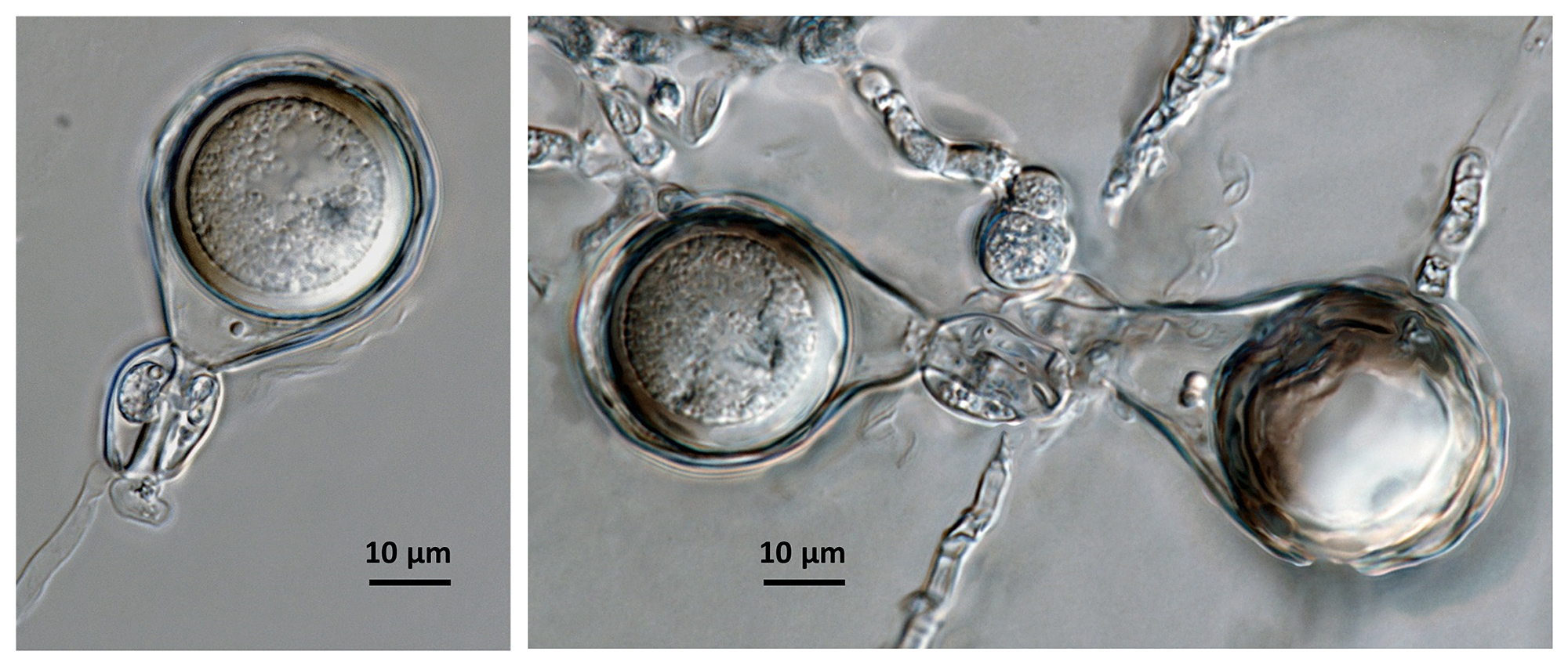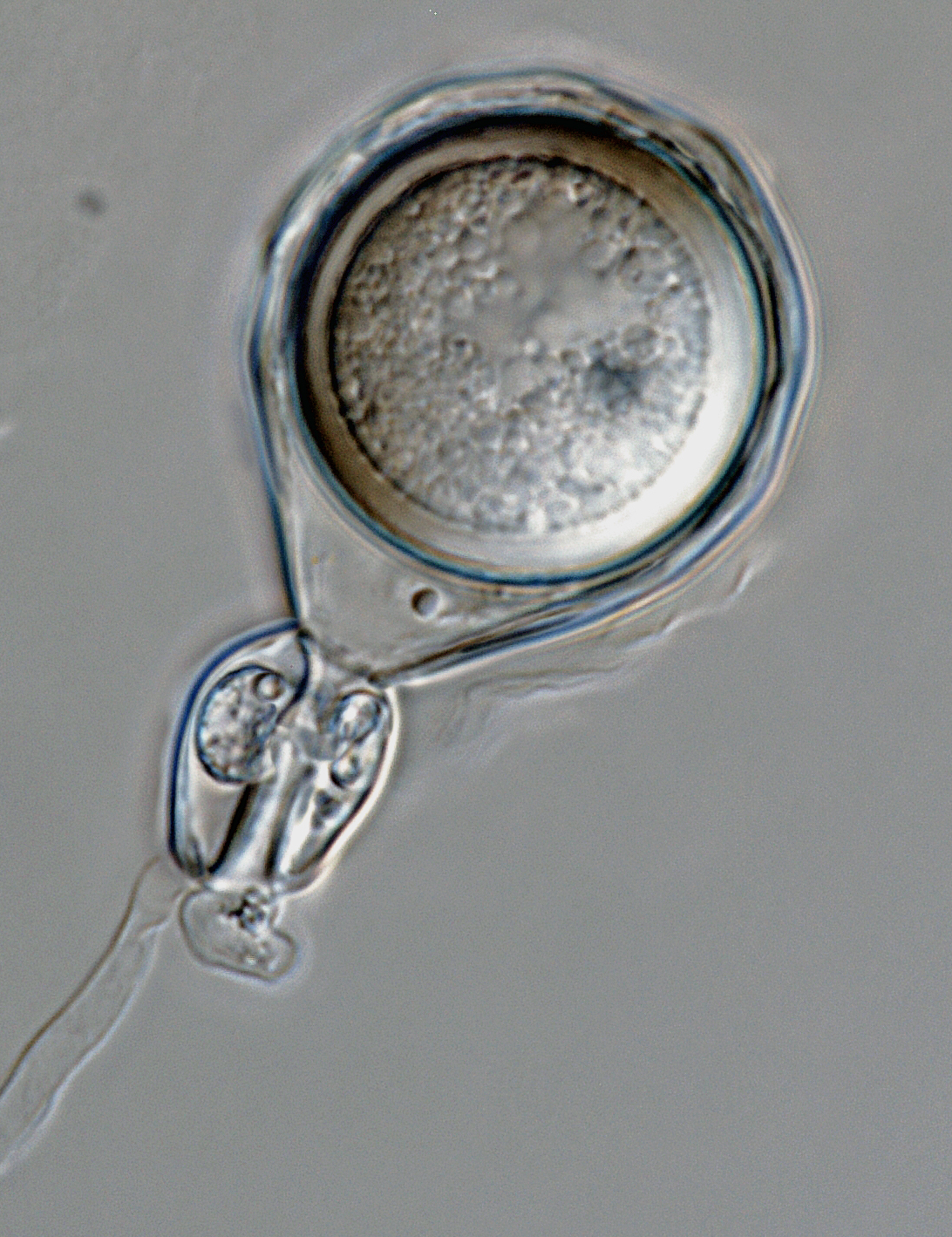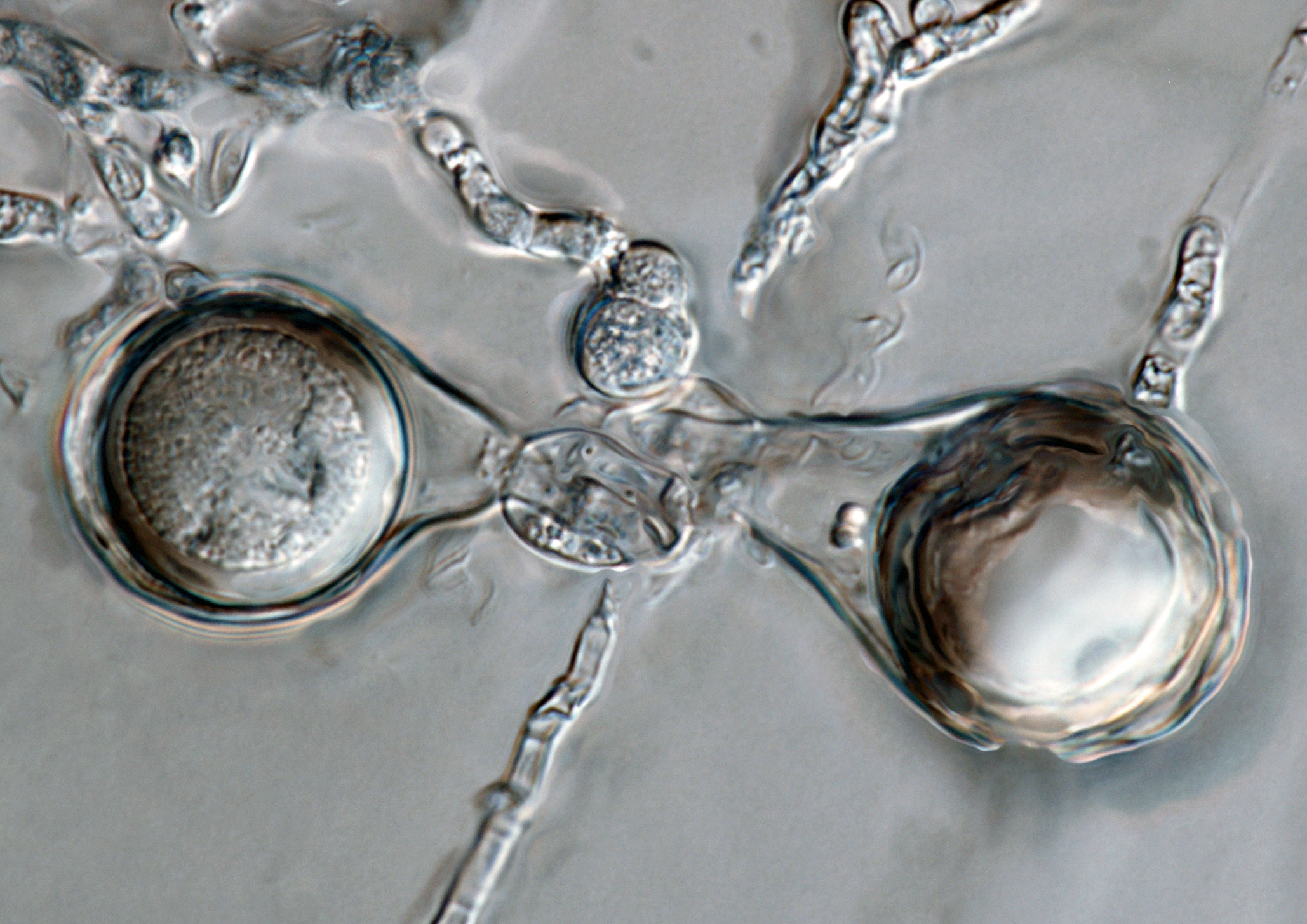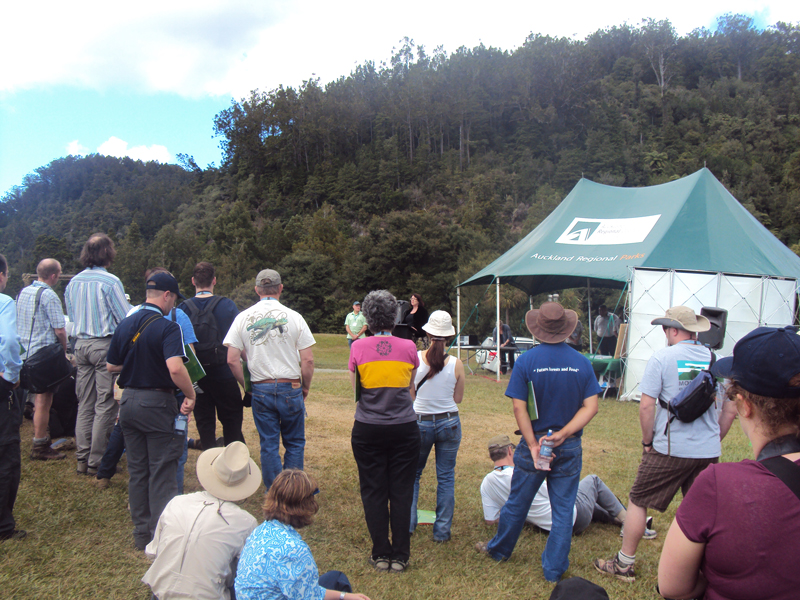Phytophthora agathidicida
|
Phytophthora spp. in Clade 5: portion of the seven-loci ML phylogeny featuring the type cultures of 212 described species (by T. Bourret). Notice the position of P. agathiidicida Ex-type CBS 149819 = S&T BL 154. Gloria Abad, USDA S&T.
|
|
Phytophthora spp. in Clade 5: Morphological Tabular key (PDF) and Tabular key legends (PDF) in IDphy2 KEY SECTION. Notice the data of P. agathiidicida Ex-type CBS 149819 = S&T BL 154. Gloria Abad, USDA S&T.
|
|
Phytophthora agathidicida (CPHST BL 154) colonies of the ex-type grown for 7 days on (a) V8® Agar, (b) potato dextrose agar, and (c) malt extract agar; photo by Krysta Jennings and Leandra Knight, USDA-APHIS-PPQ |
|
Phytophthora agathidicida (ex-type CPHST BL 154) sexual phase formed on hemp seed agar: oogonia with wavy wall and tapered base, amphyginous antheridia, and plerotic, thick-walled oospores; photos by G.Abad, USDA-APHIS-PPQ. |
|
Phytophthora agathidicida (ex-type CPHST BL 154) sexual phase formed on hemp seed agar: oogonium with wavy wall and tapered base, amphyginous antheridium, and plerotic, thick-walled oospore; photo by G.Abad, USDA-APHIS-PPQ. |
|
Phytophthora agathidicida (ex-type CPHST BL 154) sexual phase formed on hemp seed agar: oogonia with wavy wall and tapered base, amphyginous antheridia, and plerotic, thick-walled oospores; photos by G.Abad, USDA-APHIS-PPQ. |
|
Participants of the 5th IUFRO Phytophthora in Forests and Natural Ecosystems Working Group (March 7-12, 2010, Auckland and Rotorua, New Zealand) attending a presentation at the Waitakere Ranges Regional Park, west of Auckland. At this location iconic native kauri (Agathis australis) trees were affected by “kauri dieback” caused by “Phytophthora taxon agathis”; photo by Gloria Abad, USDA-APHIS-PPQ. |
|
Kauri giant tree with symptoms of bleeding canker. The New Zealand expert holds in the left hand a piece of the cortex that will be replaced, in respect of indigenous Maori traditions. Kauri holds a very significant place in their creation mythology, with the iconic trees having their own names, for example Tane-mahuta “the God of the Forest”; photo by Gloria Abad, USDA-APHIS-PPQ. |
|
kauri (Agathis australis) giant tree with symptoms of bleeding canker; photo by Gloria Abad, USDA-APHIS-PPQ |
|
Kauri dieback, caused by Phytophthora agathidicida, is specific to New Zealand kauri and can kill trees of all ages; photo courtesy of Kauri Dieback Programme Partners, New Zealand. |
|
Taking action to prevent the spread of kauri dieback, caused by Phytophthora agathidicida; photo courtesy of Kauri Dieback Programme Partners, New Zealand. |
Name and publication
Phytophthora agathidicida B.S. Weir, Beever, Pennycook & Bellgard (2015)
Weir BS, Paredes EP, Anand N, Uchida JY, Shaun R, Pennycook SEB, and Beever RE. 2015. A taxonomic revision of Phytophthora Clade clade:
a taxonomic group of organisms classified together on the basis of homologous features traced to a common ancestor
5 including two new species, Phytophthora agathidicida and P. cocois. Phytotaxa 205: 21–38 (pg. 29).
Corresponding author: WeirB@LandcareResearch.co.nz
Nomenclature
from Weir et al. (2015)
Mycobank
Index Fungorum
Etymology
Latin noun: agathid- (linguistic stem of Agathis) and -cida (suffix: one who kills)—the Agathis killer
Typification
Type: NEW ZEALAND. Coromandel: Great Barrier Island, from bleeding lesion on trunk of Agathis australis (D. Don) Lindl. ex Loudon, 23 Mar. 2006, R.E. Beever REB316-14, dried culture specimen PDD 91595. [PDD = New Zealand Fungal and Plant Disease Fungarium (New Zealand)].
Ex-type: living culture preserved in a metabolically inactive state as ICMP 17027 International Collection of Micro-organisms from Plants and P15175 (WPC - World Phytophthora Collection)
Sequences for ex-type in original manuscript: ICMP 17027 = ITS KP295308, COX1 KP295222, YPT1 KP295429, HSP90 KP295276, L10 KP295363, ENL KP295255, ND1 KP295334, TIGA KP295392
Ex-type in other collections
(ET) CBS 149819, NRRL 64473, ICMP 17027, WPC P15175, NZFS 3770, S&T BL 154 (Abad), 67D5 (Hong)
Molecular identification
Voucher sequences for barcoding genes (ITS rDNA and COI) of the ex-type (see Molecular protocols page)
Phytophthora agathicida isolate CPHST BL 154 (= P15175 WPC) = ITS rDNA MG602692, COI MK493471
Voucher sequences for Molecular Toolbox with seven genes (ITS, β-tub, COI, EF1α, HSP90, L10, and YPT1
(see Molecular protocols page) (In Progress)
Voucher sequences for Metabarcoding High-throughput Sequencing (HTS) Technologies [Molecular Operational Taxonomic Unit (MOTU)]
(see Molecular protocols page) (In Progress)
Sequences with multiple genes for ex-type in other sources
- NCBI: Phytophthora agathidicida CPHST BL 154
- NCBI: Phytophthora agathidicida ICMP 17027
- NCBI: Phytophthora agathidicida P15175 submitted to NCBI as P. katsurae or P. cf katsurae
- EPPO-Q-bank: Phytophthora agathidicida
- BOLDSYSTEMS: Phytophthora agathidicida
Position in multigenic phylogeny with 7 genes (ITS, β-tub, COI, EF1α, HSP90, L10, and YPT1)
Clade clade:
a taxonomic group of organisms classified together on the basis of homologous features traced to a common ancestor
5
Genome sequence
Phytophthora agathidicida strain ex-type NZFS 3770. Accession genome NZFS 3770 v2, BioProject PRJNA290659, University of Exeter (2015), Studholme et al. 2015
Morphological identification
adapted from Weir et al. (2015)
Colonies and cardinal temperatures
Colony colony:
assemblage of hyphae which usually develops form a single source and grows in a coordinated way
morphology after 7 days in V8-A, PDA, and MEA is non-distinctive pattern. Minimum growth temperature 6°C, maximum 25°C, and optimum 21.5°C.
Conditions for growth and sporulation
Oogonia quickly produced (3–4 days) and abundant on V8A.
Asexual phase
SporangiaSporangia:
sac within which zoospores form, especially when water is cooled to about 10°C below ambient temperature; in solid substrates, sporangia usually germinate by germ tubes
papillatepapillate:
pertaining to the production of a distinct papilla at the distal end of the sporangium (cf. nonpapillate and semipapillate)
, persistentpersistent:
pertaining to sporangia that remain attached to the sporangiophore and do not separate or detach easily (cf. caducous)
, globoseglobose:
having a rounded form resembling that of a sphere
to ovoid- ellipsoidellipsoid:
refers to a solid body that forms an ellipse in the longitudinal plane and a circle in cross section; many fungal spores are ellipsoidal or elliptic
(12–50 μm width, and 15–75 μm length), borne terminally from irregular branched or unbranched sporangiophores and could be formed via internal proliferationinternal proliferation:
internal proliferation occurs when the sporangiophore continues to grow through an empty sporangium
. Hyphal swellings simple with slight swellings. ChlamydosporesChlamydospores:
an asexual spore with a thickened inner wall that is delimited from the mycelium by a septum; may be terminal or intercalary, and survives for long periods in soil
absent.
Sexual phase
Homothallic. OogoniaOogonia:
the female gametangium in which the oospore forms after fertilization by the antheridium
globoseglobose:
having a rounded form resembling that of a sphere
(32 μm diam) with wall ornamentation mildly stipulate (small protuberances). AntheridiaAntheridia:
the male gametangium; a multinucleate, swollen hyphal tip affixed firmly to the wall of the female gametangium (the oogonium)
amphigynousamphigynous:
pertaining to the sexual stage in which the antheridium completely surrounds the stalk of the oogonium (cf. paragynous)
, globoseglobose:
having a rounded form resembling that of a sphere
, some with knots at the base. OosporesOospores:
zygote or thick-walled spore that forms within the oogonium after fertilization by the antheridium; may be long-lived
pleroticplerotic:
pertaining to an oospore that fills the oogonium (cf. aplerotic)
, nearly filling the oogoniaoogonia:
the female gametangium in which the oospore forms after fertilization by the antheridium
, with a mean diameter 28 μm.
Observations in specimen P. agathidicida CPHST BL 154 in hemp seed agar + oil: Oogonia globose (32–40 μm diam), with wavy wall ornamentation, and mostly with tapered bases (same character observed in photos of original publication of Weir et al. 2015). Antheridia amphigynous, sometimes with digitate projections. OosporesOospores:
zygote or thick-walled spore that forms within the oogonium after fertilization by the antheridium; may be long-lived
thick-walled and pleroticplerotic:
pertaining to an oospore that fills the oogonium (cf. aplerotic)
(28–36 μm diam).
Most typical characters
Phytophthora agathidicida differs from other Phytophthora clade 5 species in its oogoniumoogonium:
the female gametangium in which the oospore forms after fertilization by the antheridium
ornamentation with occasional and slightly raised protuberances, and its larger mean oosporeoospore:
zygote or thick-walled spore that forms within the oogonium after fertilization by the antheridium; may be long-lived
diameter (28 μm).
Additional specimen(s) evaluated
Phytophthora agathidicida CPHST-BL 154 (Abad) = ex-type P15175 [World Phytophthora Collection (WPC) California, USA]
Hosts and distribution
Distribution: northern New Zealand
Substrate: tree trunks
Disease note: canopy thinning - little leaf syndrome, collar-rot of lower trunk, girdling, bleeding lesions
Host: kauri (Agathis australis) trees and associated soil
Retrieved January 19, 2018 from U.S. National Fungus Collections Nomenclature Database.
Additional references and links
- SMML USDA-ARS: Phytophthora agathidicida
- EPPO Global Database: Phytophthora agathicida
- Forest Phytophthoras of the World: Phytophthora agathidicida
- CABI Digital Library: Phytophthora agathidicida
- Encyclopedia of Life (EOL): Phytophthora agathidicida
- Index Fungorum (IF): Phytophthora agathidicida
- Google All Phytophthora agathidicida
- Google Images Phytophthora agathidicida
- Google Scholar Phytophthora agathidicida
- Google All Phytophthora taxon agathis
- Google Images Phytophthora taxon agathis
- Google Scholar Phytophthora taxon agathis
Fact sheet author
Z. Gloria Abad, Ph.D., USDA-APHIS-PPQ-S&T Plant Pathogen Confirmatory Diagnostics Laboratory (PPCDL), United States of America










